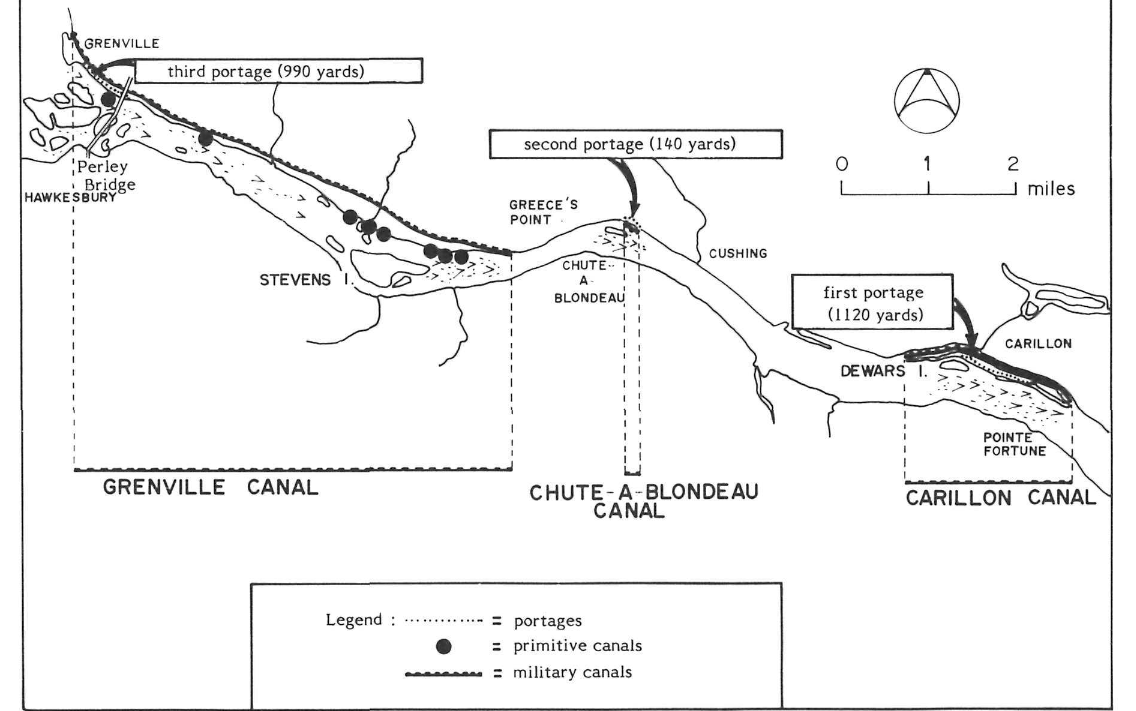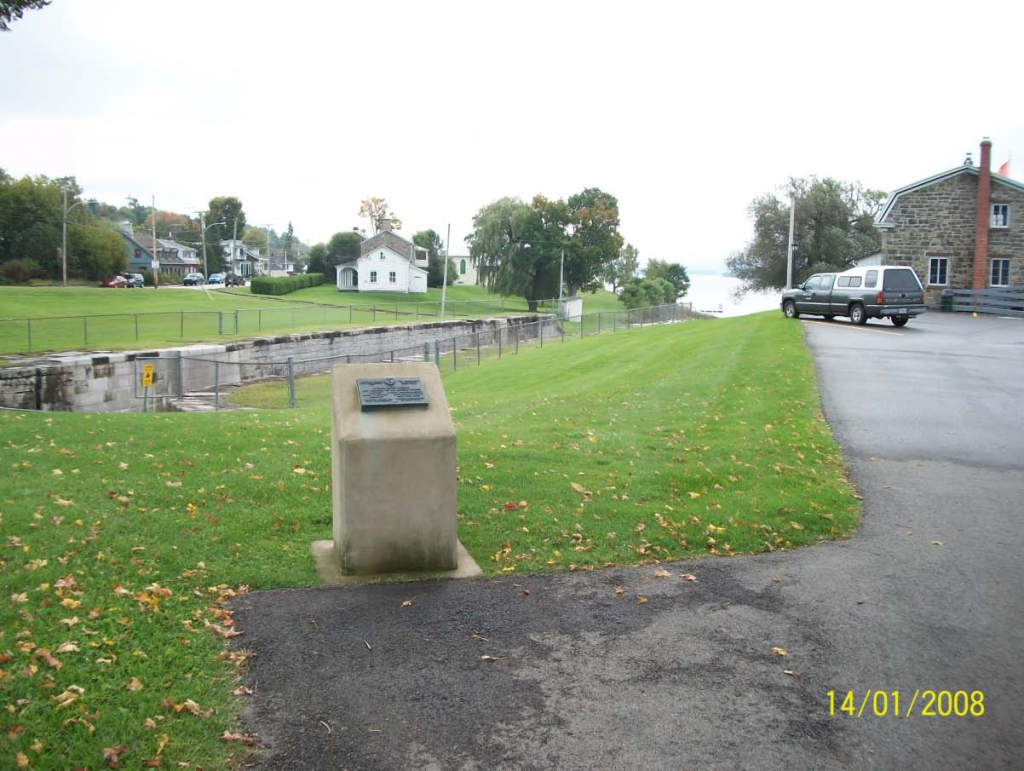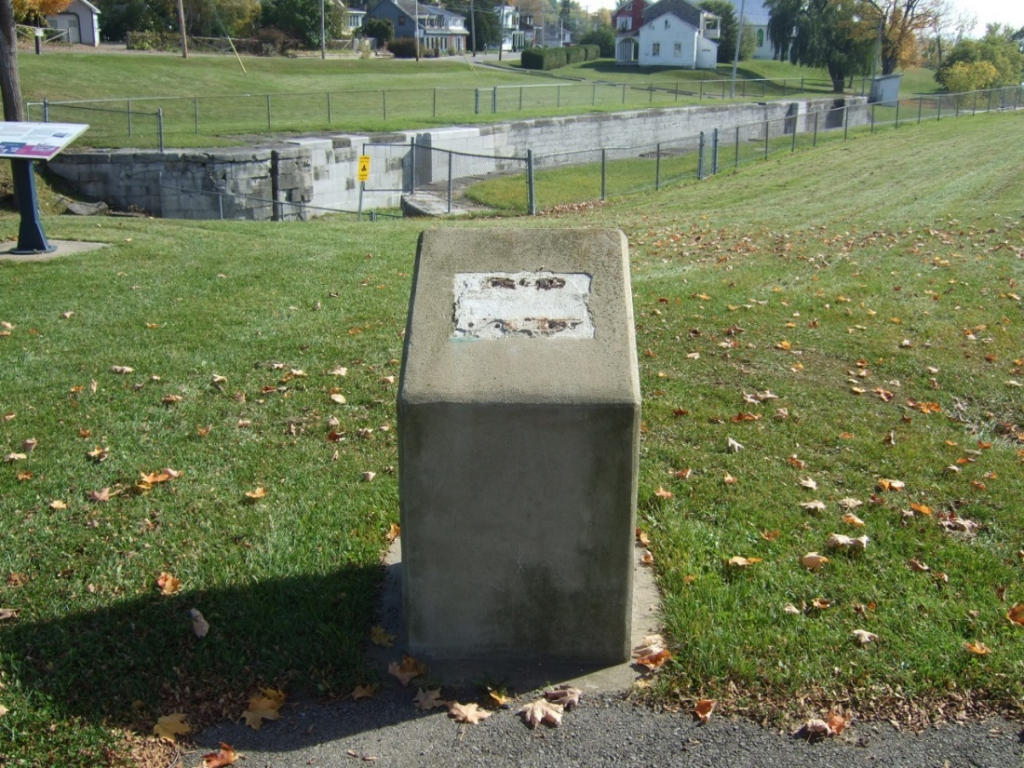
Site Locations: Grenville Canal: Lat.: 45° – 37’ – 36” N.; Long.: 74° – 36’ – 3226” W. (GPS: 45.6266325, -74.6061268). From Trans-Canada Highway 417, take the County Road 17 exit toward Hawkesbury/Rockland. Proceed west on County Road 17 for 8.1 km and turn right (north) on Tupper Street. After 2.0 km, turn left (west) on Main St. E/Prescott and Russell County Road 4. Proceed 1.8 km and turn right (north) on John St. Proceed 2.7 km, crossing the Ottawa River, and turn left (west) on Rue Principale in Grenville QC. After 1.0 km, turn sharply left onto Rue Canal Nord and turn right at the first cross street. Carillon Canal: Lat.: 45° – 34’ – 3” N.; Long.: 74° – 22’ – 36” W. (GPS: 45.5674935, -74.3766119). From the turn onto Rue Principale in Grenville, proceed 19.7 km east on QC-344 E.
Plaque Location: The plaque was mounted on a concrete pedestal overlooking an original lock, now unused, at Carillon QC. (GPS: 45.5674935, -74.3766119). Removed forcibly between 2008 and 2011, it has not been replaced.


Description: The three short Ottawa River Canals bypassed the 21 km (13 mi.) long Long Sault rapids of the Ottawa River at Hawksbury. Construction of the Grenville Canal, 9.6 km (6 mi.) long with seven locks, commenced in 1819 under the command of Lt. Col. Henry Du Vernet, an Engineer in the British Army. Construction of the canals at Chute-à-Blondeau, 0.4 km (0.25 mi.) long with one lock, and Carillon, 3.2 km (2 mi.) long with three locks, commenced in 1826. All could accommodate vessels with draughts of 1.8 m (6 ft.) and were in use by 1834.
To accommodate larger vessels, the canals were improved between 1873 and 1882 to consist of one dam, two canals and seven locks. The dam made the lock at Chute-à-Blondeau unnecessary.
Between 1959 and 1963, Hydro-Quebec erected a major dam at Carillon that submerged the canal and locks at Grenville. A new lock erected at the time of dam construction at Carillon, still in operation today to serve recreational traffic, accommodates a drop of 19 m (62 ft.).

Historic Significance: The War of 1812 demonstrated the vulnerability of using the St. Lawrence River as the communication and supply line between Kingston and Montreal, the military centres of Upper and Lower Canada, respectively. The Ottawa River Military Canals and Rideau Canal were therefore constructed to provide an alternative route that was farther from the American border and thus secure.
Unlike the Rideau Canal, the Ottawa River Military Canals were completed within budget. Their initial small capacity markedly limited the size of vessel that could use the larger Rideau Canal. Passengers travelling from Montreal to Ottawa on larger steamers would have to disembark at Carillon, travel by stage or later by rail to Grenville, and re-embark on a different vessel.
The Ottawa River Canals were never used for military purposes but became important for commercial traffic. Roughly 80% of the traffic from Ottawa to Montreal was barges laden with sawn lumber, with food and equipment to support the logging operations carried on the return trip.

Plaque Wording: CSCE. National Historic Civil Engineering Site. OTTAWA RIVER CANALS. – Grenville – Chute à Blondeau – Carillon – 1819 -1834. Engineer Lt.-Col. Henry Du Vernet. Royal Staff Corps. Canadian Society for Civil Engineering. 1984.
SCGC. Site Historique National de Génie Civil. LES CANAUX DE LA RIVIÈRE OTTAWA. – Grenville – Chute à Blondeau – Carillon – 1819 -1834. Ingénieur Lt.-Col. Henry Du Vernet. Royal Staff Corps. Société canadienne de genie civil. 1984.
Links to Online Documentation:
Normand Lafrenière, The Ottawa River Canal System, Parks Canada, 1984.